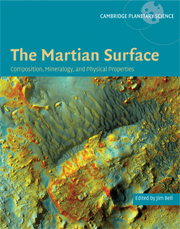Book contents
- Frontmatter
- Contents
- List of contributors
- Foreword
- Acknowledgments
- Part I Introduction and historical perspective
- 1 Exploration of the Martian surface: 1992–2007
- 2 Historical context: the pre-MGS view of Mars' surface composition
- Part II Elemental Composition: Orbital and in situ Surface Measurements
- Part III Mineralogy and Remote Sensing of Rocks, Soil, Dust, and Ices
- Part IV Physical Properties of Surface Materials
- Part V Synthesis
- Part VI Summary, Upcoming Missions, and New Measurement Needs
- Index
- Plate section
- References
1 - Exploration of the Martian surface: 1992–2007
from Part I - Introduction and historical perspective
Published online by Cambridge University Press: 10 December 2009
- Frontmatter
- Contents
- List of contributors
- Foreword
- Acknowledgments
- Part I Introduction and historical perspective
- 1 Exploration of the Martian surface: 1992–2007
- 2 Historical context: the pre-MGS view of Mars' surface composition
- Part II Elemental Composition: Orbital and in situ Surface Measurements
- Part III Mineralogy and Remote Sensing of Rocks, Soil, Dust, and Ices
- Part IV Physical Properties of Surface Materials
- Part V Synthesis
- Part VI Summary, Upcoming Missions, and New Measurement Needs
- Index
- Plate section
- References
Summary
ABSTRACT
Following the demise of the 1992 Mars Observer mission, NASA and the planetary science community completely redefined the Mars exploration program. “Follow the Water” became the overarching scientific theme. The history and distribution of water is fundamental to an understanding of climate history, formation of the atmosphere, geologic evolution, and Mars' modern state. The strategy was to search for past or present, surface or subsurface, environments where liquid water, the fundamental prerequisite for life, existed or exists today. During the 1996–2007 time frame, seven richly successful orbital and landed missions have explored the Martian surface, including NASA's Mars Global Surveyor (MGS), Mars Pathfinder Lander and Sojourner Rover, Mars Odyssey Orbiter, Mars Exploration Rovers (Spirit and Opportunity), Mars Reconnaissance Orbiter, and ESA's Mars Express (MEx) orbiter. “Follow the Water” has borne fruit. Although the Martian surface is largely composed of unaltered basaltic rocks and sand, the Rovers discovered water-lain sediments, some minerals only formed in water, and aqueous alteration of chemically fragile igneous minerals. The geological records of early water-rich environment have shown hints of profuse and neutral-to-alkaline water that later evolved to sulfurous acidic conditions as aqueous activity waned. We now have a global inventory of near-surface water occurring as hydrated minerals and possibly ice and liquid in equatorial and mid latitudes and as masses of water ice making up an unknown but potentially large fraction of the polar regolith. Martian meteorites have provided new insights into the early formation of Mars' core and mantle.
- Type
- Chapter
- Information
- The Martian SurfaceComposition, Mineralogy and Physical Properties, pp. 3 - 19Publisher: Cambridge University PressPrint publication year: 2008
References
- 5
- Cited by



